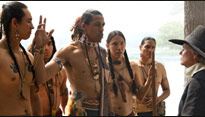Schoenbrunn Village [OH]
The Moravian church founded Schoenbrunn ("beautiful spring") in 1772 as a mission to the Delaware Indians. The settlement grew to include sixty dwellings and more than 300 inhabitants who drew up Ohio's first civil code and built its first Christian church and schoolhouse. Problems associated with the American Revolution prompted Schoenbrunn's closing in 1777. Schoenbrunn's story features a rare meeting of Indian and European cultures and a fascinating perspective on the American Revolution. Today the reconstructed village includes 17 log buildings, gardens, the original mission cemetery, and a museum and visitor center.
The village offers a short film, exhibits, and tours.
